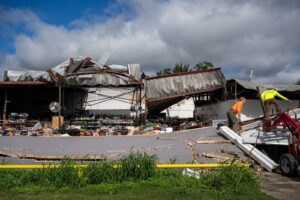China has become the first country to collect samples from the far side of the moon and bring them back to Earth in a landmark achievement for the Beijing space program.
A reentry capsule containing the precious cargo that parachuted into a landing zone in the rural Siziwang Banner region of Inner Mongolia on Tuesday after being released into Earth’s orbit by the unmanned Chang’e-6 probe.
The return of the lunar material concludes a highly successful mission for the China National Space Administration (CNSA) amid a wave of interest in which space agencies and private companies will build instruments and bases on the moon and exploit its resources.
The Chang’e-6 mission, named after the Chinese moon goddess, blasted off from southern China’s Hainan province on May 3 and touched down on the side of the moon never seen from Earth on June 2. The moon points only one face to Earth because it is tidally locked and completes one full rotation in the time it takes to circle the planet.
The mission’s lander spent two days collecting rock and soil from one of the oldest and largest craters on the moon, the 1,600-mile-wide South Pole Aitken (SPA) Basin, using a robotic arm and drill . Its ascent module then lifted off the moon’s surface and rendezvoused with the orbiter before embarking on its journey home.
“This is a great achievement by China,” said Martin Barstow, a professor of astrophysics and space science at the University of Leicester. “Recovering any samples from the moon is difficult, but doing it from the other side, where communication is particularly difficult, is a step that no other agency has taken. A true technological achievement.”
The US, China and the former Soviet Union have collected samples from the near side of the moon, but China is the first to bring home material from the far side. The intention was to collect up to 2kg of moon rock and soil.
China has previously worked with international scientists to study samples it brought back from the near side of the moon, but it is unclear whether similar access to the new material will be granted from the far side.
The latest samples may shed light on long-standing mysteries in the early history of the moon and Earth. Ian Crawford, a professor of planetary science at Birkbeck, University of London, said dating the SPA was a “key goal” of lunar science because it would establish the timeframe for lunar cratering.
Understanding the rate at which large asteroids hit the moon in its early history would shed light on Earth’s impact history, he added, since our home planet would have been hit by the same types of asteroids at the same time. “To constrain this, it is important to understand the impact regime under which life first appeared on Earth,” he said.
The collision that created the SPA basin may have scooped up enough rock to expose areas of the lunar mantle, which researchers believe are essential to understanding the history, and possibly the origin, of the moon.
“It is possible that the SPA excavated deep enough to expose the lunar mantle, and possibly that fragments could be found in the Chang’e-6 samples,” Crawford said. “It’s a long shot, but it’s worth watching.”
The other side of the moon has fewer old lava fields or maria, a thicker crust, and because it is not protected by the Earth, it offers more craters from violent impacts.
“Recovering samples from the other side is hugely exciting scientifically, as we only have very limited information about the geology there,” Barstow said. “It was processed very differently to the side of the moon facing us, which in the past was largely exposed by volcanic activity, which created the maria from which most of the samples were obtained.”
China has planned more lunar missions this decade. They are intended to pave the way for an International Lunar Research base, which it will lead with Roscosmos, the Russian space agency, and the eventual landing of a Chinese astronaut on the moon.
Dr Simeon Barber, a senior research fellow at the Open University, said: “We are entering a new era of discovery, and getting samples back from the other side is a milestone achievement that will help us to understand the geological understanding history in that region, and why it is so markedly different from the more familiar near side.
“Specialized laboratories around the world have spent five decades refining the analytical techniques to tease out the moon’s secrets from within near side samples returned by the Apollo and Luna missions. And now we’re about to apply all that expertise to learn about the enigmatic far side of our nearest neighbor in space.”






